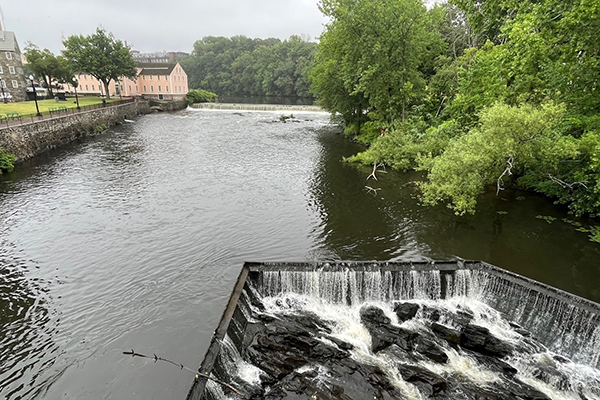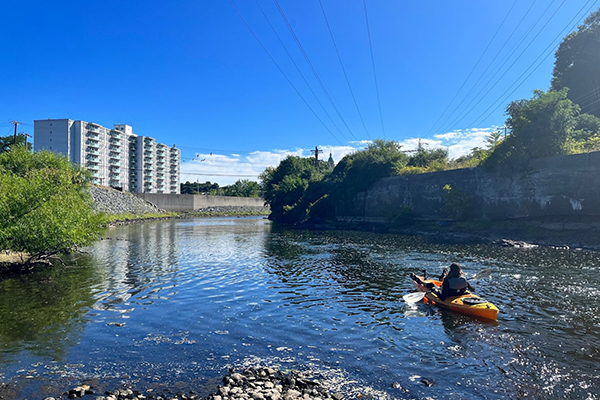
Flowing for 48 miles through Worcester, Massachusetts, and ending in Pawtucket, Rhode Island, the Blackstone River, originally known as Kittacuck by the Nipmuc people and Mishkittakooksepe by the Narragansett people, is located in the traditional, ancestral, unceded territory of the Narragansett, Nipmuc, Pokanoket, and Wampanoag Nations. As the longest freshwater tributary in Narragansett Bay, the watershed includes 1,300 acres of lakes, ponds, and reservoirs and provides habitat for nearly 40 species of freshwater fish and more than 200 species of birds.
At first glance, the freshwater biome appears fairly unassuming, but upon closer inspection and further research, you’ll find that it’s rich in both history and biodiversity. During the Blackstone’s journey from Massachusetts to Rhode Island, it drops 438 feet, at a little over 9½ feet per mile. Due to its steady decline, the river was seen as a great source of hydropower, and in 1793, it fueled the first water-powered, cotton-spinning mill. By the mid-1800s, the river and its tributaries were home to over 100 mills, and it was dammed nearly every mile for its natural power. The industrialization and construction of nearly 40 dams (19 remain) on the river’s primary stream altered the hydrology and ecology of the river and its watershed. This impacted both the aquatic organisms and the people who depend on it.
Pictured below are the last two dams on the river, Main Street Dam & Slater Mill Dam.


Starting in 2019, the Narragansett Bay Estuary Program (NBEP) hosted local outreach meetings with various universities, organizations, tribes, non-profits, watershed groups, and municipalities across the Blackstone watershed. The goal was to better understand the needs and priorities of the watershed and its surrounding communities and identify what role NBEP could play in helping meet those needs. After two years, NBEP released the Blackstone River Watershed Needs Assessment Report, highlighting 20 high-priority actions; the partners identified the number one priority as establishing a watershed collaborative group to improve capacity and work together on priority actions. From this, the Blackstone Watershed Collaborative (BWC) was born.
“There was a general appreciation for the abundance of passionate people and organizations doing work in the area, but before the collaborative was formed, everyone was focused on their own thing without seeing the bigger picture,” says BWC Program Manager Stefanie Covino. Since the collaboration formed, the BWC has focused on capacity building and supporting other organizations in the community and joined the Regional Conservation Partnership Network in 2023.

One of the Collaborative’s projects prioritizes ecological and cultural restoration of the watershed, working to increase fish passage over its four lowest dams. In 2021, BWC received the Watershed Implementation Program grant through the Southeast New England Program (SNEP). Working toward three main goals, BWC is using the funds to support the restoration of migratory fish species on the river through public engagement, highlighting indigenous communities’ connection to the river and fish passage, and hosting a dam removal conference and training session. While it’s unlikely all four dams will be removed, efforts are underway to design and install a fishway to route species around the dams and increase migratory fish species, including shad, herring, and American eel. To date, The Nature Conservancy has received a grant to pursue a design for increased fish passage over two of the dams.
Building on their collaborative success, the partner organizations are moving up the river this year, exploring options to increase fish passage over the remaining two dams. Even amid the victories they’ve worked for, Covino says it’s important not to lose sight of the ‘what’ and the ‘why.’ “This work and all its victories are built upon decades of dedication and resilience of so many people and will continue through future generations until ecological and cultural restoration has been achieved.”